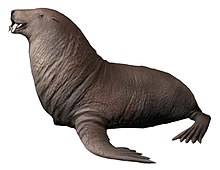Gomphotaria
| Gomphotaria | |
|---|---|

| |
| Restoration of Gomphotaria pugnax | |
| Scientific classification | |
| Domain: | Eukaryota |
| Kingdom: | Animalia |
| Phylum: | Chordata |
| Class: | Mammalia |
| Order: | Carnivora |
| Clade: | Pinnipedia |
| Family: | Odobenidae |
| Genus: | †Gomphotaria Barnes & Rashke, 1991 |
| Type species | |
| †Gomphotaria pugnax Barnes & Rashke, 1991[1]
| |

Gomphotaria is a genus of very large shellfish-eating
.Description
It was a huge-sized pinniped with skull length of around 47 cm (19 in), surpassed only by Pontolis, which had a skull of 60 cm (24 in) long.[2] Gomphotaria had comparatively small eyes, increased upper and lower canines and four tusks, with one pair in the lower and upper jaws.[clarification needed] According to wear on the tusks, G. pugnax hammered shellfish open, rather than simply sucking them out of their shells as do modern walruses.[2] In terms of the postcranial skeleton, Gomphotaria and other dusignathine walruses were built more like sea lions than modern walrus. Gomphotaria is a prime example of the extreme diversity that walruses once exhibited.
References
Wikimedia Commons has media related to Gomphotaria.
Wikispecies has information related to Gomphotaria.
- ^ a b Barnes, L. G. and R. E. Raschke. 1991. Gomphotaria pugnax, a new genus and species of Late Miocene Dusignathine Otariid Pinniped (Mammalia: Carnivora) from California. Natural History Museum of Los Angeles County, Contributions in Science 426:1-16.
- ^ a b
Annalisa Berta (2017). The Rise of Marine Mammals: 50 Million Years of Evolution. Johns Hopkins University Press. p. 110. ISBN 978-1-4214-2325-8. Retrieved 2022-08-21.




